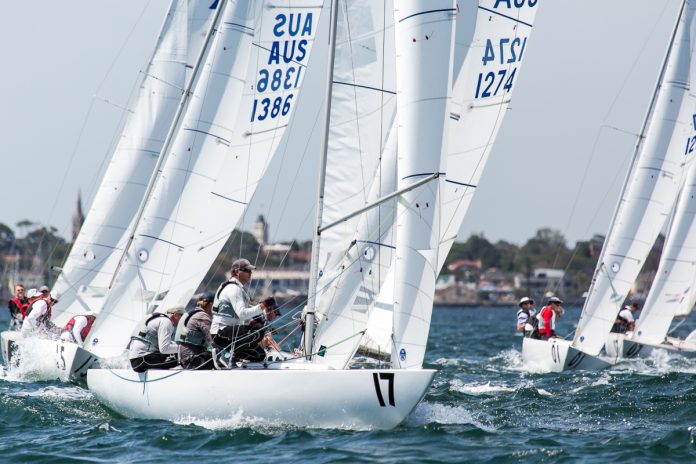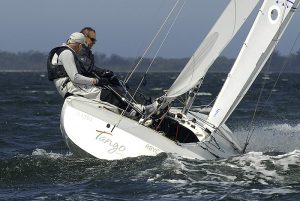

I have copied below excerpts from an interview that I did with sailing professional Sam Haines about race and regatta preparation.
Currently Sam is racing in the Etchells and their team has a boat in Europe as well as Australia.
Sam has a vast sailing background and is a qualified sailmaker, having worked in the industry for 19 years. He had his own loft in Melbourne, Australia and until recently, worked with North sails as their One Design specialist.
Brett: Speaking of regattas, your team sailed in the World Etchells in the UK where you did really well. Can you give us a bit of background on how you prepared for that regatta?
Sam : So for the Worlds, obviously it’s a big event. It’s a long event.
So what we did is we actually went to the venue about six weeks prior to the event. We went over there for 12 days. We did a one off local event, and we did a few days of training with the guys that we did the World’s with.
So that was one, you check in with the venue.
Two, you know where you’re going to eat your dinner at night. You know where your house is. There’s a lot in a regatta preparation and just having an understanding of where you’re going.
You’re not trying to sort out where to get your toothpaste from the day of the racing.
So we went over and did those 12 days. We then came home, back to Aussie for a couple of weeks. Caught up with family life and all of that sort of stuff.
Then we went back 10 days prior to the World’s.
We did four days of intense coaching. We had a day off, off the boat, didn’t go near the water for a day.
Then we’re into the Europeans and the World’s, so it was quite a long-winded exercise but there’s no substitute for the variety.
You don’t win the regatta on the last day. It’s what we took away from it. We obviously didn’t win it, but we battled, as well as we could expect for the regatta.
Brett: Obviously that preparation worked really well because the score was excellent. Once you’re on the water and before the start, what do you do as part of your preparation?
Sam: So with a world or a nationals program, I would suggest you want to be at the starting area an hour prior to a race.
Usually the race committee will be on station or there about at that sort of time. We would get comfortable, obviously, sail or a tow out to the start line, get there an hour before, by the time you get to that start line an hour before you would have had your sandwich and get comfortable.
You’ve got your kit that you’re actually going to race in on, we would then do a little up wind exercise.
Hopefully, you’ve got a mate that you have an understanding with to do a little two boat up wind preparation probably for 15 minutes.
Pull the kite up, come down, really intense as if you were racing. Pumping the kite, a few jibes, all the rest of it.
Get back to that starting area, by then you’re probably looking at a half an hour, 20 minutes prior to the start.
Around that time, we would have another mini break have a water and a sandwich.
By that time the committee will have your start line in. We would then from the middle of the line, we would sail up wind.
Again, couple of tacks, get your numbers. You’re now getting within 10 minutes of the 5 minute gun at this time.
Couple of tacks, get your numbers correct, head to wind before you come back down wind. Then you’ve got an understanding of whether it’s left, right or in between.
What we actually do at that point is sail to which ever end we think is going to be the correct end to start at.
Let’s say it’s going to be a pin end bias line. We’ll come down towards the pin, wander down there.
All this is just having your head switched on that we are actually racing right now. We’re not cruising up and down behind the boat.
What you’ll find in any big fleet and I’m sure everyone has a story to tell with that.
But everyone reaches up and down behind the line flogging their gear and half the guys well, not half of them, but there’s always a little collision along the way.
No one’s really switched on, so you are actually intensely getting into your racing, a bit like football. You’re in the rooms, half an hour before, pumping each other up. Same deal.
So you’re staying out of the mess. Then you’re in that five minute sequence and then obviously it comes down to racing.
It’s a moving picture, but you’ve done this little bit of homework so you know when you do a head to wind with two and a half minutes to go and the breeze has actually gone right that you actually need to get up towards the boat, you’re actually in that mode.
Whereas if you’ve just raced up and down you don’t actually know where the wind is.
Brett: During that period, do you actually look at your main competitors? especially if it’s getting to the pointy end of the regatta. Do you try and keep away from them? Do you try and dog them?
Sam: Well, I’m a firm believer in not racing one boat in the fleet.
And especially in an Etchells type of fleet or any large class, you don’t really get away with it. You end up beating yourself along the way.
I’m an honest believer in sail your own race. Obviously, as the regatta goes on and you’ve usually done a lead up event, say with a worlds you’ve done a Europeans or Nationals or whatever.
You know from previous events that X,Y and Z, you don’t want to start to windward of those guys because that’ll make your life hard. Or there becomes an amount of people so you have a little plan “O there’s so and so, let’s go a couple of boat lengths up from them”.
Start at the right end or towards the right end. You don’t have to win that end. Again I’m a fan of if it’s a boat end start, it’s not going to hurt you being four boats down from the boat end.
You’re going to get away nice and neat. As long as you’re on the boat there’s going to be 10 boats there, 1 boat’s going to win it and the rest of them are going to lose.
Brett: I noticed that you guys have spent a lot of time getting your boat just right having easy to operate systems. But I see plenty of unnecessarily complicated boats. Have you found that’s been an important part of how you guys have improved?
Sam: I think there’s two parts to that. And one is that preparation in that everything works 100%. You need to have gone out and tested that six months prior to the event.
There’s also the other side of it is having that set up for the people that you’ve got on the boat.
We had an instance at the World’s, we got a new person on the bow of the boat, I was doing the bow previously. I had it set up the way that works for me, but our new guy, Mark, he wanted to change a few things.
To make it was easier to hike, there was a couple of the control lines that he wanted to change to different positions.
You’ve got to have an open mind, I basically see it that the boat is a tool.
It’s not a piece of beauty that you’ve got sitting on there that you want to keep. You know, it’s however you make it work.
We changed some things during the regatta to suit him. So you make it custom to the people using it.
Some of the control lines we moved back to me because of the understanding that I had.
So you have to set up the boat to what works for the people in the boat.
Not to what somebody says this is how your Etchells or your 505 have to be set up. You’ve got to work it into you.
The Sailing To win Membership site has a video and transcription of the complete interview as well as plenty of others on a multitude of sailing subjects. Click the button above to get lifetime access to these interviews and others that will be added from time to time.
